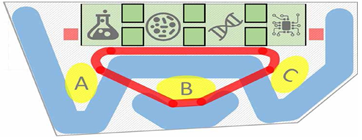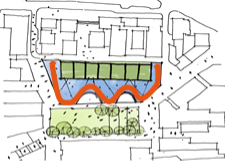Designed and built to support teamwork & collaboration
The ARC is the largest project in the University’s investment portfolio. It represents a £116.5million investment in research at Glasgow and will be our flagship research facility.
Below we outline some facts and figures about the ARC and discuss the design concept behind the ARC’s unusual shape.
Facts and figures
- £116.5milllion flagship research building at the heart of the University’s west end campus
- Capacity for over 1,800 people in the building.
- The ARC is BIG - 6 floors, over 100m long, 43m at its widest point and measures 24m to the top of the building.
- The ARC has approx. 3580m2 of lab space in a 16,000m2 building. This roughly equates to ¼ of the space being STEM labs.
- There are approximately 550 desks in the ARC. A mixture of Principal Investigator offices, open plan and shared offices.
- The atrium and exhibition space is approx. 700m2.
- Level 2 can accommodate up to 1118 people.
- The ARC has a publicly accessible café.
- The main seminar room on level 2 can take up to 140 delegates.
Design
The ARC has been designed to benefit the whole University, enabling teamwork, collaborative research and external engagement.
The building forms the west side of a new square within the expanded campus on the western infirmary site. A new public route moves through the building at the entry level, connecting the new University square to the West End community. With a glass frontage the activities of the ARC will be displayed to the outside world, supporting the University’s intention to be open, inclusive and transparent.
The ground floor of the ARC (level 2) features a large central atrium filled with natural light and includes a café (coming Spring 2022) and multipurpose engagement space. It includes exhibition spaces to display research, a custom-built space for immersive technologies (ARC XR) and seminar spaces available to anyone from the University community.
There are 5 levels in the ARC:
- Level 1 hosts core facilities and building support
- Level 2 connects people with a wide range of spaces for engagement
- Level 3 – 5 provides three floors for interdisciplinary research
The shape of the ARC
 |
 |
Our architects, HOK, designed the building to maximise daylight and views for researchers working in both labs and other research/scholarly spaces. The design creates collaboration areas to maximise social and professional interactions amongst colleagues.
The proximity of lab space, research/scholarly space, informal meeting space and communal space creates a dynamic, efficient and interactive research environment.
In the above illustration interaction areas - A, B, C – are where colleagues will naturally coalesce. These areas have been designed to be open and encourage communication and spark interest. In these areas we hope colleagues will come across research teams developing ideas. Not chance encounters but intentional engagement and exchanges.
Areas A and C have the potential to become “research neighbourhoods”, collaboration centres for around 60-80 colleagues who share a common theme or goal. These “research neighbourhoods” are large enough to create a critical mass of ideas and interdisciplinary discourse, but not large enough to produce anonymity.

